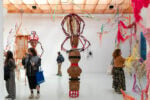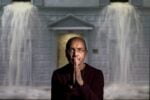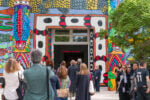Oscar Abraham Pabón / Eugenia Vanni – An Archaeology of the Oath
.jpg)
Doppia personale di Oscar Abraham Pabón e di Eugenia Vanni dal titolo “An Archaeology of the Oath” a cura di Lorenzo Bruni.
Comunicato stampa
La Galleria Fuoricampo di Siena è lieta di presentare sabato 1 ottobre dalle ore 12.00 la doppia personale di Oscar Abraham Pabón e di Eugenia Vanni dal titolo “An Archaeology of the Oath” a cura di Lorenzo Bruni.
La doppia personale “An Archaeology of the Oath” è costituita da sei opere dei due artisti, Oscar Abraham Pabón e di Eugenia Vanni, di provenienza culturale e geografica differente, che utilizzano tutte le tecniche a loro disposizione - come l’oggetto quadro, la pratica del disegno, la scultura in ceramica, il processo fotografico ed il supporto audio/video - per creare un dialogo diretto tra contenitore (architettonico e concettuale) e contenuto su diversi livelli di lettura. Le singole “presenze”, infatti, sono accomunate dall’intento di concretizzare un’atmosfera, piuttosto che rappresentare l’immagine del reale; con cui i due artisti puntano a dare maggiore valore alla pratica di immaginazione dell’invisibile o dei dettagli delle cose. Questa è la loro personale risposta alla necessaria riformulazione del dialogo tra spazio personale e spazio collettivo al tempo delle piazze virtuali, tra i new media dell’estetica, al tempo del “digitale” e la storia dell’arte, fatta anche di scoperte di materiali e tecniche artistiche differenti che si stratificano tra loro dal medioevo ad oggi.
Le opere realizzate appositamente per l’occasione da Eugenia Vanni - un quadro quasi monocromo su cui è ritratta una pennellata, un’installazione di telai di differenti colori realizzati con la tecnica medioevale della tempera all’uovo e poi poggiati su una mensola posti come a isolare differenti porzioni della parete retrostante, oltre ad un dittico composto da un disegno di un paesaggio di natura e un’immagine fotografica di alcune posate d’argento – e quelle di Oscar Abraham Pabón appartenenti a progetti differenti e associate specificatamente per la sua prima mostra italiana – un intervento ambientale con ceramiche che riproducono imballi industriali posti su scatole di cartone per traslochi accostati ad una parete come a misurarne l’estensione, due fotografie di un asciugamano catturato nella sua trasformazione in possibile scultura pubblica e il video di un’azione al pianoforte dell’artista stesso in cui cerca di riprodurre un’esecuzione del musicista minimalista Steve Reich – puntano a “caratterizzare” o “sensibilizzare” lo spazio espositivo per porre l’attenzione sulla fiducia che può essere instaurata tra osservatore e oggetto osservato al di là di delle apparenze iniziali.
Le singole ricerche di Oscar Abraham Pabón (Venezuela, 1984) e di Eugenia Vanni (Italia, 1980) sono indagabili approfonditamente per mezzo del confronto particolare che stabiliscono tra di loro le opere in mostra. Allo stesso tempo questo confronto porta a concretizzare in una sensazione specifica la riflessione di fondo che hanno in comune i due artisti, ovvero: quale possa essere nell’epoca della post-modernità liquida il confine tra oggetto trovato e oggetto creato, tra presentazione e rappresentazione, tra osservare un manufatto umano e condividerne con gli altri movente e utilizzo che lo differenzia da tutti gli altri. Queste tematiche sono evocate dal titolo - preso in prestito dal libro “Il sacramento del linguaggio. Archeologia del giuramento” uscito nel 2008 e scritto dal filosofo Giorgio Agamben – che rimanda alle dinamiche che il soggetto da sempre deve stabilire tra la sua percezione del mondo e le cose che lo circondano, tra la regolamentazione del suo spazio personale e di quello collettivo, tra i massimi sistemi e la comunità in cui vengono applicati.
Sarà possibile vedere altri due interventi di Oscar Abraham Pabón e Eugenia Vanni al ristorante la Torre, celeberrima osteria senese, al civico 7 della stessa via. L’istallazione dei lavori che si intromettono mimeticamente nell’ambiente conviviale sottolinea l’attitudine dei due artisti non solo a confrontarsi con gli oggetti quotidiani e a costruire per essi nuove poetiche narrative su un piano collettivo, ma anche con la storia dell’arte, indagando i luoghi comuni interpretativi che ancora oggi sopravvivono nell’opposizione di astratto/figurativo.
L’opening si svolgerà il 1° ottobre dalle 12.00 alle 20.00 in Galleria FuoriCampo, Via Salicotto 1/3, angolo di Piazza del Campo; si ringrazia l’Azienda Agricola Montechiaro per le bottiglie d’autore (etichetta Eugenia Vanni).
La mostra rimarrà visibile fino al 28 Novembre 2016.
Oscar Abraham Pabón (Venezuela, 1984; vive e lavora a Parigi) ha passato gli ultimi due anni ad Amsterdam per partecipare al programma di residenza della celebre Rijksakademie presentando il suo lavoro nell’open studio del 2014 e 2015. Nel mese di novembre inaugurerà la sua prima grande personale in Sud America, al Museo MAC a Santiago del Cile. Il suo lavoro, già in importanti collezioni, è stato ospitato da gallerie e istituzioni. Tra queste si ricorda: nel 2016 la sua partecipazione al Salón de Jóvenes con FIA, Museo d’Arte Contemporanea di Zulia MACZUL, Maracaibo, Venezuela; nel 2015 la sua personale alla Galleria Martin van Zomeren di Amsterdam; nel 2013 The Right to the City, Stedelijk Museum Bureau, Amsterdam e Transient Urbanisms, Centro Colombo Americano, Bogotá; mentre nel 2011 partecipa a ‘Enemies of my Enemies’, [hot young Venezuelan art today] Graduate Gallery, OCAD University, Ontario, Toronto.
Eugenia Vanni (Italia, 1980; vive e lavora a Siena), la sua formazione avviene a Milano dopo un periodo nello studio di Luca Vitone ed il biennio specialistico in visual arts and curatorial studies, alla NABA. Tra i musei che hanno accolto sue mostre personali si ricorda: “Il Vero colore de cielo” museo MAN, Nuoro, 2015; “Rinviai la mia partenza” Museo internazionale e biblioteca della musica, Bologna, 2015; “Sturm und drang” Museo Marino Marini, Firenze, 2012. Ha esposto in numerose collettive, si ricord: “La sottile linea del tempo, works from AGI collection”, Fondazione Museo Miniscalchi-Erizzo, Verona, a cura di Marinella Paderni, 2015; FuoriCampo Temporary Space, Brussels, Belgio, 2014; Oltre il Giardino, Palazzo Fabroni, Pistoia, a cura di Ludovico Pratesi, 2013; Cartabianca-Firenze, Museo di Villa Croce, Genova, 2012, a cura di Lorenzo Bruni., PLAY-START, Pecci Museum, Milano, 2011
Da febbraio 2016 è direttrice con l’artista Francesco Carone del Museo D’inverno a Siena.
An Archaeology of the Oath
Oscar Abraham Pabón | Eugenia Vanni
curated by Lorenzo Bruni
opening 1sh october h 12
3rd October - 28th November 2016
Starting on Saturday 1 October, at 18.00, Galleria Fuoricampo in Siena will present a double solo show by Oscar Abraham Pabón and Eugenia Vanni, entitled “An Archaeology of the Oath”, curated by Lorenzo Bruni.
The double solo show “An Archaeology of the Oath” consists in six works by the two artists, Oscar Abraham Pabón and Eugenia Vanni. The artists come from different cultural and geographical backgrounds, but they use all the techniques available to them – such as the canvas-as-object, the practice of drawing, ceramic sculpture, the photographic process and audio/video support – to create a direct dialogue between the container (architectural and conceptual) and content, at various different levels of interpretation. Indeed, the individual “presences” are linked by a common intention to render an atmosphere in concrete form, rather than represent an image of reality. The two artists thereby aim to give greater value to the practice of imagining the invisible, or details of things. This is their personal response to the necessary reformulation of the dialogue between personal space and collective space in the age of the virtual meeting-place, between the new media of aesthetics, in the “digital” era and the history of art, also made up of discoveries of differing artistic materials and techniques which have followed each other, like layers coming one after the other, ever since the medieval period.
The works created specially for the occasion by Eugenia Vanni – an almost monochrome canvas on which is traced a brush-stroke, an installation of frameworks of different colours created using the medieval technique of egg tempera and then placed on a shelf such as to isolate different portions of the wall behind, as well as a diptych composed of a drawing of a nature landscape and a photographic image of silver cutlery – and those by Oscar Abraham Pabón belonging to different projects now brought together specifically for his first show in Italy – an environmental work with ceramics reproducing industrial packaging, placed on cardboard boxes (for house removals) resting against a wall as if to measure their size, two photographs of a towel captured as it transforms into a possible public sculpture, and a video of an action on the piano by the artist himself in which he tries to reproduce a performance by the minimalist musician Steve Reich – aim to “characterize” or “make aware” the exhibition space, to place attention on the trust which may be established between the observer and the observed object, beyond initial appearances.
The individual researches by Oscar Abraham Pabón (Venezuela, 1984) and by Eugenia Vanni (Italy, 1980) can be explored in more depth through the particular relationship which the works on show establish between themselves. At the same time, this relationship ends up creating a specific sensation from the underlying reflection which the two artists have in common, namely: in the liquid, post-modern era, what boundary may exist between the found object and the created object, between presentation and representation, between observing a human artefact, and sharing with others its motive, and the use which differentiates it from all others. These themes are suggested by the title – borrowed from the book “The Sacrament of Language. An Archaeology of the Oath”, written by the philosopher Giorgio Agamben, and published in 2008 – which discusses the dynamics which the subject has always
had to establish between his perception of the world and the things which surround him, between the regulation of his personal space and collective space, and between chief world systems and the community in which they are applied.
It will also be possible to view two other works by Oscar Abraham Pabón and Eugenia Vanni at “La Torre”, a well-known Sienese restaurant, at number 7 in the same street. The installation of works, which are discreetly camouflaged among the restaurant’s interior, stresses how much the two artists are skilled at engaging not only with everyday objects, building new narrative poetics for them on a collective basis, but also with art history, investigating the interpretative clichés which still survive today in the opposition between abstract and figurative.
The opening will be held on 1 October from 12.00 to 20.00 in FuoriCampo Gallery, Via Salicotto 1/3, corner of Piazza del Campo. The exhibition will be on display until 28 November 2016.
Oscar Abraham Pabón (b. 1984, Venezuela) is Architect. (2003-2008.) and is a former resident of the Rijksakademie van beeldende kunsten, Amsterdam, NL. (2013-2014) He will open this fall his solo exhibition at MAC Museo de Arte Contemporaneo, Santiago de Chile. His previous exhibitions include institutions such as Museum of Contemporary Art of Zulia MACZUL, Maracaibo, Venezuela (2016). In, out and between, nube gallery, Santa Cruz de la Sierra, Bol.(2015). #Oficina 1, Caracas (2014), Stedelijk Museum Bureau, Amsterdam (2013), Centro Colombo Americano, Bogotá (2013) and Centro de Arte Los Galpones, Caracas (2011).
Eugenia Vanni (Italy, 1980; lives and works in Siena), he trained in Milan after a period in the study of Luke headwork and the degree course in visual arts and curatorial studies at the NABA. Among the museums that have hosted her personal exhibitions: “Il Vero colore de cielo” museo MAN, Nuoro, 2015; “Rinviai la mia partenza” Museo internazionale e biblioteca della musica, Bologna, 2015; “Sturm und drang” Museo Marino Marini, Florence, 2012. She has participated in several group shows: “La sottile linea del tempo, works from AGI collection”, Fondazione Museo Miniscalchi-Erizzo, Verona, curated by Marinella Paderni, 2015; FuoriCampo Temporary Space, Brussels, Belgio, 2014; Oltre il Giardino, Palazzo Fabroni, Pistoia, curated by Ludovico Pratesi, 2013; Cartabianca-Firenze, Museo di Villa Croce, Genova, 2012, curated byLorenzo Bruni., PLAY-START, Pecci Museum, Milano, 2011. Since February 2016, she is director (with the artist Francesco Carone) of the Museo d’Inverno in Siena.



